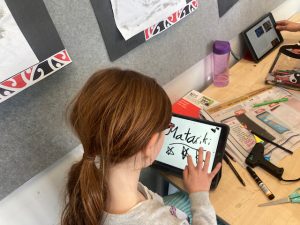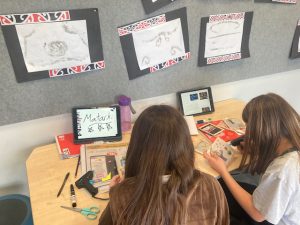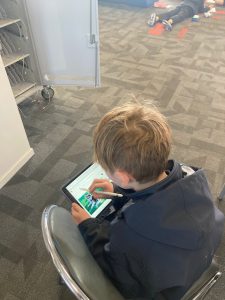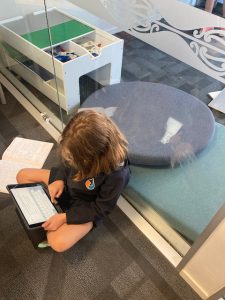Digital Technologies
Technology in the classroom over the past five years has been one of the biggest changes we have seen in education. Digital technologies used in a positive and creative way can be very beneficial for education . Ararira Springs Primary has clear policies and procedures around digital technologies in the classroom. The school works closely with REV IT who looks after our IT systems and has a wealth of knowledge when it comes to digital technologies.
Positives about technology in the classroom:
- Full participation and digital tools allow teachers to pose questions and everyone in the class to think of their own response. The teacher can then plan the next lesson accordingly.
- Teachers can set students a short video to watch, e.g. youtube video about a skill or task. The students can watch the video and learn the skill, without requiring the teacher to be beside the student.
- Enables completed classroom work to be shared with the extended family.
- Teachers can send an activity via google classroom, therefore less printing is required.
- Students can give more informative and engaging oral presentations.
- Teacher instruction can be supplemented with a video that clarifies a particularly hard-to-explain concept or idea. This can be watched as many times as required.
- Students create an informative video presentation in place of a standard oral presentation.
- Connecting students with other people around the world as part of their learning journey.
- Teachers/students do a recording as they deliver a presentation or practice a physical skill, then use this recording to prompt student reflection
- Students publish their work online where it can be viewed by peers and the broader community.
- Students have easy access to experts and information.
- Students learn programming skills and debugging solutions.
- Develop competency in the best tool for the job
- Create great digital content.
Negatives about Digital Technologies in the classroom
- Students can get distracted by others who are using digital technologies.
- Students could use the devices inappropriately.
- Students could use copy and paste from the internet and therefore breach copyright.
- Students can be tempted to multitask with other online alternatives.


Digital Technology and Cybersafety Policy
Digital technology has a vital role in teaching and learning, running our workplaces, and our daily lives. Many of our students are digital natives and we are committed to creating digital citizens. We value our internet facilities and ICT digital technology equipment and the benefits they bring us in teaching and learning and the effective operation of the school. This policy applies to every member of the school community using digital technology equipment, including staff, students, volunteers, trainees, contractors, special visitors, and board members. Digital technology equipment includes computers, tablets, storage devices, cameras, cellphones, gaming consoles, smartwatches, video/audio devices, and other similar devices. This policy applies to digital technology owned by the school, owned privately and used at school or any other location for a school-based activity. It also includes off-site access to the school network.
We actively encourage our students to use digital technology confidently and competently by learning how to keep themselves safe online and manage challenges and issues, including understanding and meeting privacy and copyright laws, and protecting digital devices and equipment. As defined by Netsafe, a digital citizen:
- is a confident and capable user of ICT
- uses technologies to participate in educational, cultural, and economic activities
- uses and develops critical thinking skills in cyberspace
- is literate in the language, symbols, and texts of digital technologies
- is aware of ICT challenges and can manage them effectively
- uses ICT to relate to others in positive, meaningful ways
- demonstrates honesty and integrity and ethical behaviour in their use of digital technology
- respects the concepts of privacy and freedom of speech in a digital world
- contributes and actively promotes the values of digital citizenship.
Cybersafety
In keeping with our Health, Safety, and Welfare policy, we follow procedures to guide our use of the internet, mobile phones, and other digital devices and equipment. We maintain a cyber-safe school environment by:
- educating students, staff, and the school community about the safe and responsible use of information and communication technologies ensuring that the school’s ICT network, hardware, and software are effectively maintained and secure, including content filtering (safe searches)
- using helpful resources, such as those provided by Netsafe
- allowing for professional development and training for staff
- setting and sharing clear guidelines about acceptable and unacceptable use of the technology, and monitoring these guidelines
- following clear guidelines about publishing student information online
- having a clear process for dealing with breaches of the policy or agreements, including any incidents of cyberbullying – see Responding to Digital Incidents
- following guidelines for the surrender and retention of digital devices
- ensuring that members of the school community understand the policy, and commit to it by signing the appropriate use agreement which outlines requirements and expectations
The school maintains the right to monitor, access, and review digital technology use, including email use, and to audit material on school equipment. The school may also ask to audit privately-owned digital devices/equipment used on the school site or at any school-related activity. The school may use a third party, such as N4L, to monitor school internet use. This may include browsing history.




Recent Comments